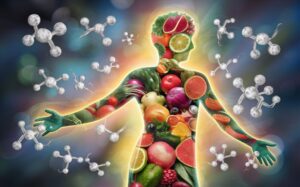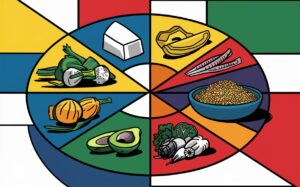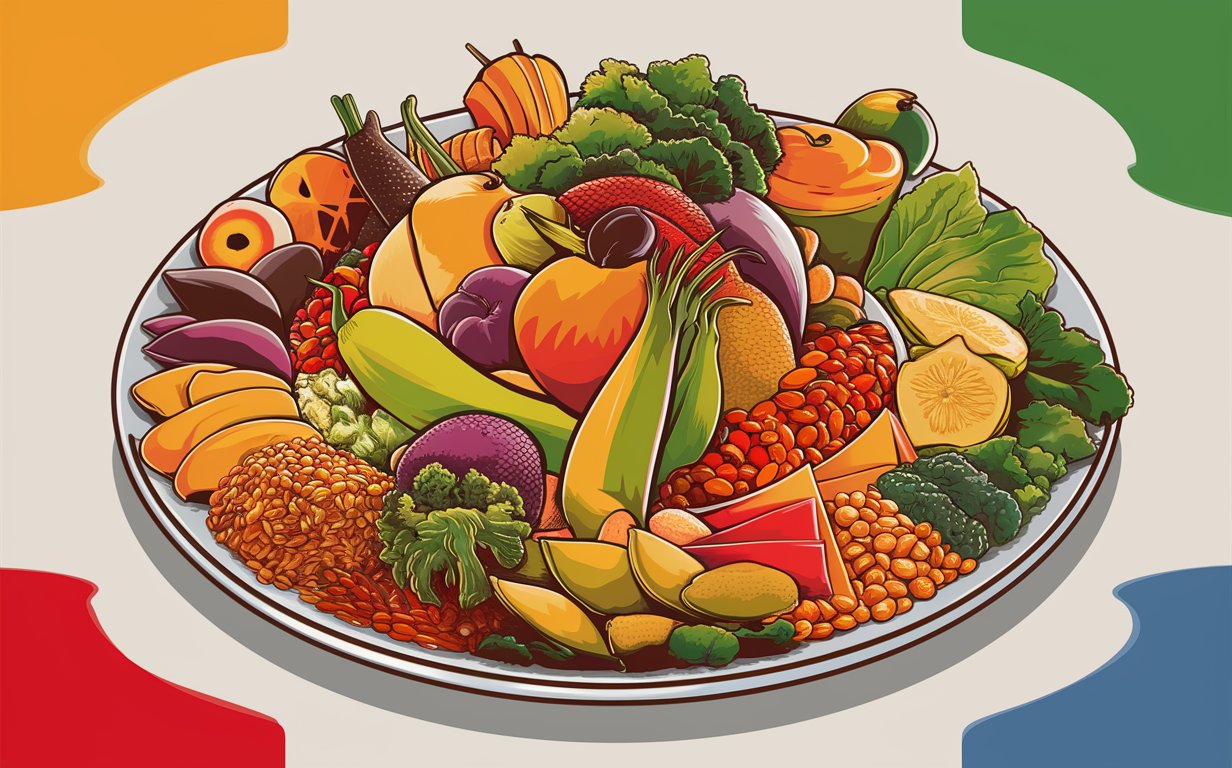Last Updated on August 20, 2024 by Alexander Sennuga
Curious about mastering a vegan diabetic diet? Managing diabetes while maintaining a plant-based lifestyle is a challenge, but you’re not alone, and we’ve got game-changing tips to share.
Imagine maintaining balanced blood sugar levels while indulging in delicious, plant-based meals. Whether you’re newly diagnosed or a vegan veteran, navigating a diabetic diet can open doors to exciting food possibilities.
Picture this: enjoying meals that not only satisfy your taste buds but also support your health goals. A vegan diabetic diet is rich, diverse, and anything but restrictive, offering a world where wellness and flavour coexist.
Ready to transform your eating habits? Dive into our guide and discover the vibrant synergy between veganism and diabetes management.
Let’s journey toward a tastier, healthier future together!
Benefits of a Plant-Based Diet for Diabetes

A vegan diabetic diet can offer numerous benefits for individuals managing diabetes.
Finally, adopting a vegan lifestyle may improve overall well-being by increasing energy levels and reducing complications associated with diabetes, such as kidney and nerve damage.
By focusing on nutrient-rich, plant-based foods, individuals can not only manage their diabetes more effectively but also enhance their quality of life.
Research has shown that a plant-based diet can be beneficial for managing diabetes, particularly type 2 diabetes. Some key benefits include:
- Improved insulin sensitivity
- Lower blood sugar levels
- Reduced risk of cardiovascular disease
- Weight management
- Increased fiber intake
A study published in the Journal of Geriatric Cardiology found that plant-based diets can help prevent and treat type 2 diabetes by improving insulin sensitivity and reducing inflammation.
Key Components of a Vegan Diabetic Diet

A vegan diabetic diet focuses on balancing blood sugar levels and promoting overall health through plant-based nutrition. Key components include high-fiber foods such as whole grains, legumes, fruits, and vegetables, which help regulate glucose levels.
Healthy fats from sources like avocados, nuts, and seeds are also essential, as they provide energy without spiking blood sugar. Lean plant-based proteins, such as tofu, tempeh, and lentils, support muscle maintenance and prevent excessive calorie intake.
Keeping processed foods and added sugars to a minimum is crucial for managing diabetes effectively. By prioritizing these components, a vegan diabetic diet can help control blood sugar and improve overall well-being.
A well-planned vegan diabetic diet should include:
- Complex carbohydrates: Whole grains, legumes, and starchy vegetables
- Non-starchy vegetables: Leafy greens, broccoli, cauliflower, and bell peppers
- Plant-based proteins: Tofu, tempeh, legumes, and nuts
- Healthy fats: Avocado, nuts, seeds, and olive oil
- Low-glycemic fruits: Berries, apples, and citrus fruits
It’s crucial to balance these components to maintain stable blood sugar levels while meeting nutritional needs.
Meal Planning for Vegan Diabetics
Meal planning for a vegan diabetic diet involves strategically selecting foods that promote stable blood sugar levels and overall health. Begin by focusing on high-fiber foods, such as whole grains, legumes, vegetables, and fruits, as they help maintain steady glucose levels.
Incorporate lean plant-based proteins like tofu, tempeh, and chickpeas to support muscle health and satiety. Include healthy fats from avocados, nuts, and seeds to provide energy without causing blood sugar spikes.
Limit processed foods and sugars, which can disrupt glucose control. Portion control and consistent meal timing are crucial to avoid blood sugar fluctuations. Use herbs and spices to add flavor without excess salt or sugar.
Planning meals ensures a varied and balanced intake of nutrients. Breakfast might feature oatmeal with berries and almond butter, while lunch could include a hearty salad with quinoa and chickpeas.
For dinner, consider a vegetable stir-fry with tofu and brown rice. This structured approach to a vegan diabetic diet supports effective diabetes management.
Effective meal planning is essential for managing diabetes on a vegan diet. Here are some tips:
- Use the plate method: Fill half your plate with non-starchy vegetables, a quarter with complex carbohydrates, and a quarter with plant-based proteins.
- Monitor portion sizes to control carbohydrate intake.
- Include a variety of colorful fruits and vegetables to ensure a wide range of nutrients.
- Plan meals and snacks to avoid impulsive food choices.
- Consider using a food-tracking app to monitor nutrient intake and blood sugar levels.
Vegan Diabetic Breakfast Ideas

Vegan diabetic breakfast options can be both delicious and nutritious. Start your day with a bowl of oatmeal topped with fresh berries and a sprinkle of nuts for a filling meal that’s low in sugar.
Another tasty choice is whole-grain toast spread with avocado and a side of sliced tomatoes. For a protein-packed option, try scrambled tofu with vegetables like spinach and bell peppers.
Smoothies made with plant-based milk, leafy greens, and a small amount of fruit can also be a quick and easy breakfast. Don’t forget about chia seed pudding, which can be prepared the night before and customized with various toppings.
These vegan breakfast ideas are not only diabetes-friendly but also provide essential nutrients to keep you energized throughout the morning.
Starting the day with a balanced, blood sugar-friendly breakfast is crucial. Here are some vegan diabetic breakfast options:
- Overnight oats with chia seeds, berries, and unsweetened plant-based milk
- Tofu scramble with spinach, mushrooms, and whole-grain toast
- Smoothie bowl with low-glycemic fruits, spinach, and plant-based protein powder
- Whole-grain avocado toast with hemp seeds and sliced tomatoes
- Chickpea flour pancakes with sugar-free berry compote
These breakfast ideas combine complex carbohydrates, plant-based proteins, and healthy fats to help stabilize blood sugar levels throughout the morning.
Lunch and Dinner Options for Vegan Diabetics

Vegan diabetics have many tasty and healthy options for lunch and dinner. They can enjoy colorful salads with lots of veggies, beans, and nuts.
Soups made with lentils or vegetables are filling and good for blood sugar. Stir-fries with tofu and low-carb veggies like broccoli or cauliflower are quick and easy. Whole grain wraps stuffed with hummus and raw veggies make a great on-the-go meal.
For dinner, grilled portobello mushrooms can replace meat in many dishes. Roasted vegetables with herbs and a side of quinoa provide a balanced plate.
Zucchini noodles topped with tomato sauce and plant-based meatballs are both fun and diabetes-friendly.
With these choices, vegan diabetics can eat well and keep their blood sugar in check.
For lunch and dinner, focus on creating balanced meals that include a variety of nutrients. Some ideas include:
- Lentil and vegetable soup with a side salad
- Quinoa and black bean bowl with roasted vegetables and avocado
- Stir-fried tofu and vegetables with brown rice
- Zucchini noodles with homemade tomato sauce and vegan meatballs
- Chickpea curry with cauliflower rice
Remember to include a good source of plant-based protein, complex carbohydrates, and plenty of non-starchy vegetables in each meal.
Snacks and Desserts for Vegan Diabetics

Snacks and desserts can be a delightful part of a vegan diabetic diet when chosen wisely. The key is to focus on options that are low in added sugars and high in fiber, protein, and healthy fats to help stabilize blood sugar levels.
For snacks, consider fresh fruit with a serving of nuts or nut butter, sliced vegetables with hummus, or a small portion of roasted chickpeas.
Unsweetened Greek yogurt with berries or a homemade trail mix made with seeds, coconut flakes, and dark chocolate chips can also make satisfying choices.
For desserts, opt for naturally sweet options like baked apples with cinnamon, chia pudding with fresh fruit, or a small serving of dark chocolate. Vegan diabetic-friendly baked goods made with whole grains, minimal added sugars, and healthy fats can also be enjoyed in moderation.
By incorporating these nutrient-dense snacks and desserts, vegan diabetics can satisfy cravings while maintaining blood sugar control.
Choosing the right snacks and desserts is important for maintaining stable blood sugar levels. Some options include:
- Apple slices with almond butter
- Hummus with carrot and cucumber sticks
- Roasted chickpeas
- Chia seed pudding with berries
- Sugar-free, vegan dark chocolate
For desserts, focus on natural sweeteners like stevia or small amounts of fruit.
Consider making your treats to control ingredients and portion sizes.
Nutritional Considerations for Vegan Diabetics
Vegan diabetics face unique challenges when it comes to managing their blood sugar levels while following a plant-based diet.
They need to pay close attention to their food choices to ensure they get enough protein, vitamins, and minerals without consuming too many carbohydrates.
Beans, lentils, and tofu are excellent sources of protein for vegan diabetics, while leafy greens and nuts provide essential nutrients. They need to focus on whole grains and complex carbohydrates, which release energy slowly and help keep blood sugar stable.
Avoiding processed foods and added sugars is crucial, as these can cause rapid spikes in blood glucose. Regular meals and snacks throughout the day can help maintain steady energy levels.
Vegan diabetics should work closely with a dietitian to create a balanced meal plan that meets their nutritional needs while keeping their diabetes under control.
While a vegan diet can be nutritionally adequate, some nutrients require special attention:
- Vitamin B12: Found mainly in animal products, supplementation is necessary for vegans.
- Iron: Plant-based sources include leafy greens, legumes, and fortified foods.
- Omega-3 fatty acids: Consider algae-based supplements or include foods like flaxseeds and walnuts.
- Calcium: Fortified plant milk, leafy greens, and calcium-set tofu are good sources.
- Vitamin D: Sunlight exposure and fortified foods or supplements may be necessary.
Consult with a registered dietitian to ensure all nutritional needs are met while managing diabetes.
Tips for Transitioning to a Vegan Diabetic Diet
Transitioning to a vegan diabetic diet can be a healthy choice, but it requires careful planning. Start by gradually replacing animal products with plant-based alternatives rich in protein, such as beans, lentils, and tofu.
Focus on eating whole grains, fruits, and vegetables to maintain balanced blood sugar levels. Monitoring carbohydrate intake and choosing foods with a low glycemic index is crucial. Be sure to include sources of vitamin B12, iron, and omega-3 fatty acids often found in fortified foods or supplements.
Consult with a dietitian to ensure you’re meeting all your nutritional needs while managing your diabetes. Remember to stay hydrated and exercise regularly to support overall health.
With patience and dedication, you can successfully adopt a vegan diabetic lifestyle that promotes both animal welfare and your well-being.
If you’re new to a vegan diabetic diet, consider these tips:
- Gradually replace animal products with plant-based alternatives.
- Experiment with new recipes and ingredients to keep meals interesting.
- Learn to read food labels to identify hidden animal products and added sugars.
- Join online communities or support groups for vegan diabetics.
- Work closely with your healthcare team to monitor your blood sugar and adjust medication as needed.
Conclusion
A vegan diabetic diet can be a healthy and sustainable way to manage diabetes while aligning with ethical and environmental values. By focusing on whole, plant-based foods and carefully planning meals, it’s possible to maintain stable blood sugar levels and improve overall health.
Remember to consult with healthcare professionals, including a registered dietitian, when making significant dietary changes. With proper planning and support, a vegan diabetic diet can be a fulfilling and health-promoting lifestyle choice.
Ready to try a vegan diabetic diet? Start by incorporating one plant-based meal per day and gradually increase as you become more comfortable with the lifestyle.
Share your experiences and favorite recipes in the comments below!

